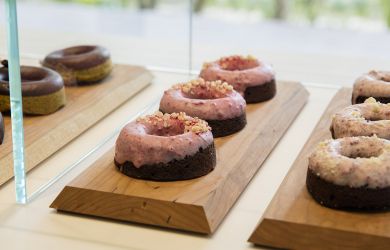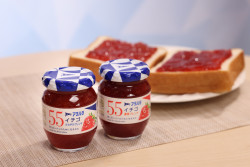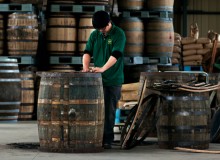
Originally published on metropolis.co.jp on October 2012

This island nation is blessed with waters crammed with a rich variety of seafood. Add to that the unique care and attention paid by Japanese fishermen and fishmongers to preserve their wares’ freshness from the moment they are caught. Simple preparations are then employed to allow the seafood’s texture, flavor, and freshness to shine.
Novices should start with shiromi (white-flesh fish) like suzuki (sea bass) or tachiuo (cutlassfish). More adventurous eaters will be happy with hikarimono (silver-skinned fish) like aji (Japanese horse mackerel), saba (Pacific mackerel), or sanma (Pacific saury). Some seasonal seafood dishes this time of year to try are seared katsuo (bonito), simmered kinmedai (splendid alfonsino), ankou (monkfish) nabe, grilled tachiuo, or miso-marinated and grilled tara (Pacific cod).
Autumn and winter is a special time for seafood. As the waters turn cold, nature does its job fattening up fish to keep them warm. This results in rich rewards when seafood is grilled. Sashimi or sushi becomes tender and melts in your mouth. Here are four restaurants that go out of their way to procure top quality seafood to serve at the table.
Nihon Sengyo Kokakurui Dokokai Shinjuku Ebi-dori Honbu
In the hot and bothered streets of Kabukicho, you can ease your spirit just by gazing on the fresh seafood on ice at this casual 24-hour izakaya. The shop, part of a chain, receives its wares directly from ports around the country—with no markets in the middle. Look for the red lanterns adorning the upper windows of this three-story building.
Seasonal sashimi is the best way to appreciate the freshness of the seafood. Shichirin (table-top charcoal grills) are perfect for grilling skewered whole shrimp, hamaguri (common Orient clam) on the half-shell, or sazae (turban shell) in their shells. There is also a hearth with charcoal for grilling skewers.
As the seafood selection changes daily, menu items are written in Japanese script on large papers hanging from the walls. This time of year try some awabi (abalone) or benizuwaigani (red snow crab). Some seafood is butterflied and hung up to dry in the restaurant, a classic himono technique. Drinks to pair well with seafood include fuguhirezake (blowfish fin in hot sake), local sake, and shochu. The restaurant is open 24-hours-a-day if you find yourself in Kabukicho craving seasonal Japanese seafood.
1-3F Kabukicho 1-22-3, Shinjuku-ku. Tel: 03-5287-2568. www.hamakura-style.com/work/koukaku.html
Uoriki Kaisen Sushi
Amid the hectic hoity-toity area of Meguro station Atré, is the flagship store of a fishy sensation. The bulk of Uoriki’s business is as a retail seafood specialist with shops throughout the region, including Shibuya Tokyu and Ikebukuro Tobu. The shop’s buyers have years of experience and excellent connections where it matters—at Tsukiji Market. This allows for quality products at good prices. And as they are purchasing seafood both for retail shops and restaurants, their price is hard to beat.
The specialty of the shop is sushi and our favorite sets include the ichiba (“market”) set and the shun no tokusen (“seasonal specials”), both of which include the current catches. For a heartier lunch go for the donburi, including the kaisendon (seasonal seafood rice bowl).
Diners tend to linger more in the evening as there is a well-selected list of sake and shochu, including Nakanaka barley shochu. The ippin ryori (small dishes) of deep-fried octopus or ika no shiokara (squid and innards) are perfect sake partners.
2-16-9 Kami-Osaki, Shinagawa-ku. Tel: 03-6408-8378. http://meturl.com/uoriki
Yanmo
Imagine a direct line stretching from the Izu Peninsula to Minami-Aoyama. That’s the path fresh seafood takes to get onto your plate at this restaurant—with no deviations.
The dinner menu offers elegant, elaborate courses, but we love Yanmo for the great set lunch centered on sumiyaki—grilled fish seasoned simply with salt or miso. The sweet, white Saikyo miso adds a subtle sweetness to the fish. Seasonal fish recently have included saba, sanma, sawara (Japanese Spanish mackerel), and kuromutsu (Japanese bluefish). There are also plenty of rice and miso soup refills for those who can’t get enough. Counter seats are great for solo diners, while horigotatsu seats offer a view of a small garden. Don’t be discouraged if there is a line, as it moves quickly. There is also a Yanmo at the Shin-Tokyo Building in Marunouchi.
5-5-25 Minami-Aoyama, Minato-ku. Tel: 03-5466-0636. www.yanmo.co.jp/aoyama
Namikibashi Nakamura

At this Shibuya izakaya seasonal seafood and produce are the centerpiece, with daily changing menus rewarding multiple visits. Go in the evening (or when you have a free afternoon…) to try the excellent sake and shochu selection that includes a slightly fruity Yakiimo Kurosawa.
Some recent seafood dishes include a namero dish of sashimi and miso as well as sanma simmered with umeboshi—both perfect partners for sake—and ochazuke. Most of the times the menu will list the provenance of the seafood such as Edo anago (eel) or Odawara kamasu (barracuda).
Check out Nakamura’s blog to see what’s being served. In October there is a kinmedai shabu-shabu, perverting your preconceptions about what goes best in the traditional stew dish. Other highlights include squid and autumn vegetables simmered in a ginger broth or zuwaigani (crab) in a vinegar dressing.
3-13-5 Shibuya, Shibuya-ku. Tel: 03-6427-9580. http://ameblo.jp/fg-nakamura







